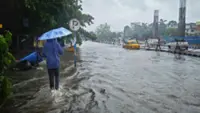Tangkuban Perahu is one of around 130 active volcanoes in Indonesia. — Photos: CAROLA FRENTZEN/dpa
The road winds gently up the mountain from the town of Lembang on Indonesia’s main island of Java. The half-hour journey takes you through forests full of giant trees rising from the fertile volcanic soil.
But then, all of a sudden, the landscape changes.
Upon reaching the summit of Tangkuban Perahu at an altitude of around 2,000m, breathtaking views open up into the Kawah Ratu or Ratu crater – including a bright blue lake.
Hot vapours rise from the cracks in the vegetation-free volcanic rock.
The strong smell of sulphur tickles your nose. Ash and cooled lava give the slopes a moon-like appearance. This inhospitable barrenness makes the scenery all the more dramatic.
What makes it so special? To experience Indonesia’s spectacular mountains of fire up close, holiday makers don’t always need to plan hours-long trekking tours. Sometimes you can drive to the crater’s edge – as is the case with Tangkuban Perahu.
An insider tip
The volcano is around a three-hour drive from Indonesia’s capital, Jakarta, and a one-hour drive from the city of Bandung, which is popular with tourists for its surrounding hot springs and tea plantations.
The region is popular with visitors from other Asian countries, with the province of West Java remaining an insider tip for those from further afield.
“The last time the volcano experienced multiple eruptions was in 2019, but the ash barely reached the car park and it wasn’t a major threat,” says Hassan, who sells souvenirs at the Ratu crater. He lives in a village about 7km away.
“People are no longer allowed to live closer due to safety concerns,” he explains.
Back in 2019 the volcano was closed down for visitors for several months.
Before that, the stratovolcano erupted in 2013, sending a column of ash 500m into the sky – after it had been dormant for almost 30 years. There were no fatalities or injuries.
A crater tour with a horse
Visitors can explore the Kawah Ratu on a guided horseback tour or on foot until early afternoon. There are about a dozen other, smaller craters. Three of these are also popular tourist destinations, although they can only be reached by foot.
The Domas crater, which is slightly further down, is known for its hot springs. You’ll need to take a short hike to get there, but once you’re there you can have a go at cooking eggs in the boiling water.
The name Tangkuban Perahu (also known locally as Parahu) translates as “upside-down boat” and refers to the shape of the volcano. Legend has it that the volcano was formed when a young man named Sangkuriang tried to build a giant boat overnight to im- press his mother, Dayang Sumbi.
When this failed, he is said to have kicked the unfinished boat in frustration, causing it to tip over – and the mountain was formed. – dpa
When to go: The best time to visit is during the dry season – from May to November.
Entry fees: For foreigners, access to the volcano costs IDR200,000 (RM52) per person.
Other info: Indonesia, the world’s largest island state, lies on the Pacific Ring of Fire, the most geologically active zone on Earth. Earthquakes and volcanic eruptions occur frequently along this belt. There are around 130 active volcanoes in Indonesia.







